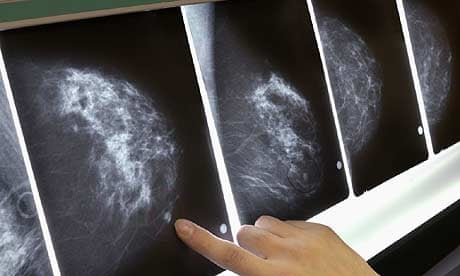The country's biggest cancer charity has expressed shock at government figures revealing huge variations in patients' chances of surviving from one area of the UK to another. The biggest survival gap was in lung cancer, where Department of Health figures showed patients in Herefordshire were three times more likely to die within a year of diagnosis than those in Kensington and Chelsea. In the London borough, 44% of patients survived the first year after diagnosis, compared with only 15% in Herefordshire.
In bowel cancer there was also a big gap in survival – 80% in Telford and Wrekin after one year, but only 58% in Waltham Forest and Hastings and Rother. The gap was less pronounced in breast cancer, with the best rate in Torbay, where 99% survived for one year, compared with 89% in Tower Hamlets.
"There is no excuse for such a big difference between different areas," said Harpal Kumar, chief executive of Cancer Research UK. "It is appalling that someone with lung cancer in Herefordshire should be three times more likely to die within a year than a patient in Kensington, or that a person diagnosed with bowel cancer in Waltham Forest or Hastings should be 22% more likely to die within a year than a patient in Telford. This is the worst kind of postcode lottery."
Very few primary care trusts (PCTs) had survival rates that were as good as other countries in Europe now or even as good as Europe was achieving 10 years ago, which Kumar called "a disgrace".
"We're pleased that the Department of Health have been bold enough to publish these figures," he said. "The NHS now needs to take them very seriously."
One-year survival figures highlight the issues around delayed diagnosis of cancer. That can be partly the responsibility of the GP, who may not see many cancer cases in a year, but is often to do with the reluctance of the patient to seek medical advice when they suspect a problem.
The figures are contained in the Cancer Reform Strategy second annual report from national cancer director Mike Richards, who points out that cancer deaths continue to fall and that prevention efforts, such as the cervical cancer vaccination programme for schoolgirls and better screening, will further help.
Jeremy Hughes, chief executive of Breakthrough Breast Cancer, said the charity shared the concerns. "Although progress has been made in some parts of the country, in others key Cancer Reform Strategy initiatives are still yet to be implemented," he said. "In particular, urgent action must be taken to ensure that digital mammography is in place by the December 2010 deadline and that, as previously committed by the government, all women with breast problems referred by their GP will see a specialist within two weeks by the end of this year."
